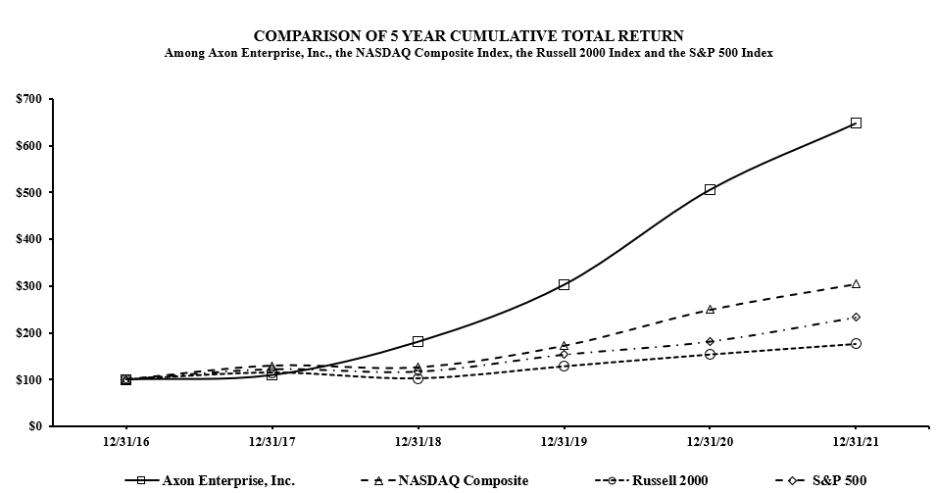The primary competitive factors in this market include a device’s accuracy, effectiveness, reputation, safety, cost, ease of use, and exceptional customer experience. The design maturity of the TASER platform, as well as our development and sale of a two-shot device, are also key competitive differentiators. We are aware of competitors providing competing CED products primarily in international markets.
TASER for Personal Safety: In the private citizen market, TASER devices compete with firearms and with other less-than-lethal self-defense options such as stun guns and pepper spray-based products including pepper guns and miniature spray cans. The TASER StrikeLight competes in the flashlight category, in which there are dozens, if not hundreds, of competitors, including tactical flashlight providers with and without stun-gun capabilities.
TASER personal safety devices are not stun guns, and have different capabilities, including NMI (neuro-muscular incapacitation) functionality. The broader market for personal safety and home defense is far-reaching, and categories range from threat detection and accountability (dash and doorbell cameras), to home security (home alarms, locks, and response services) to personal defense (firearms, stun guns, TASER devices, pepper spray, tactical flashlights, and personal alarms), to personal tracking and emergency notification mobile applications.
The primary benefit of TASER devices is in less-than-lethal stopping power. Other competitive factors include a device’s cost, effectiveness, safety, ease of use, and available training options.
Sensors — Connected Cameras and Digital Evidence Management Software: The body-worn camera and in-car video/automatic license plate readers market is highly competitive. Our competition includes Motorola Solutions, Utility Associates, Getac, Panasonic Corp., Reveal Media, Coban Technologies, L3 Mobile-Vision, Digital Ally, Visual Labs, Intrensic, LLC, as well as Safety Vision, Rekor, and Genetec.
The market for software solutions to improve public safety agency workflows is both highly fragmented and highly competitive. Our cloud-based digital evidence management system, Axon Evidence, competes with both cloud-based platforms and on-premises based systems designed by third-parties or developed internally by an agency's technology staff. Our competition includes Motorola Solutions, Panasonic Corp., IBM, Oracle, FotoWare, Vidizmo, NICE, QueTel, OpenText, and FileOnQ among others.
Key competitive factors in this market include product performance, product features (including live-streaming, GPS tracking, and pre-event buffering), battery life, product quality and warranty, total cost of ownership, data security, data and information workflows, company reputation and financial strength, and relationships with customers.
Productivity and Real-Time Operations — Records Management System (RMS) and Computer Aided Dispatch (CAD): The RMS and CAD markets are highly competitive and highly fragmented. We have identified more than 50 software providers, including Motorola Solutions, Tyler Technologies, Central Square Technologies (formerly Superion, TriTech and Aptean), Northrop Grumman, Hexagon AB, Niche Technology Inc., Caliber Public Safety (parent, Harris Systems USA), Saab, SOMA Global, RapidDeploy, Sopra Steria, and Mark 43 Inc. In addition, not all law enforcement agencies use software for report writing — some still use paper. We believe our network of camera sensors and digital evidence management platform give us a strategic advantage in these product categories. Our Respond offering competes both with real-time operations platforms that ingest body camera video feeds, like Motorola’s CommandCentral Aware, Hitachi's Visualization Suite and Genetec's Citigraf as well as platforms that ingest video feeds exclusively from surveillance cameras, like Rave Mobile Safety, LiveEarth and Mutualink among others.
Seasonality
We have historically experienced higher net sales in our fourth quarter compared to other quarters in our fiscal year due primarily to municipal budget cycles. Additionally, new product introductions can significantly impact the cadence of net sales, product costs and operating expenses. Municipal law enforcement budgets tend to feature a mix of fiscal years that end in either June, September or December. However, historical seasonal patterns, municipal
